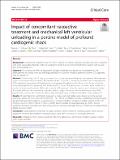| dc.contributor.author | Udesen, Nanna L J | |
| dc.contributor.author | Helgestad, Ole K L | |
| dc.contributor.author | Banke, Ann B S | |
| dc.contributor.author | Frederiksen, Peter H | |
| dc.contributor.author | Josiassen, Jakob | |
| dc.contributor.author | Jensen, Lisette O | |
| dc.contributor.author | Schmidt, Henrik | |
| dc.contributor.author | Edelman, Elazer R | |
| dc.contributor.author | Chang, Brian Yale | |
| dc.contributor.author | Ravn, Hanne B | |
| dc.contributor.author | Møller, Jacob E | |
| dc.date.accessioned | 2020-07-22T18:44:42Z | |
| dc.date.available | 2020-07-22T18:44:42Z | |
| dc.date.issued | 2020-03-18 | |
| dc.identifier.issn | 0969-6822 | |
| dc.identifier.uri | https://hdl.handle.net/1721.1/126319 | |
| dc.description.abstract | BACKGROUND: Concomitant vasoactive drugs are often required to maintain adequate perfusion pressure in patients with acute myocardial infarction (AMI) and cardiogenic shock (CS) receiving hemodynamic support with an axial flow pump (Impella CP). OBJECTIVE: To compare the effect of equipotent dosages of epinephrine, dopamine, norepinephrine, and phenylephrine on cardiac work and end-organ perfusion in a porcine model of profound ischemic CS supported with an Impella CP. METHODS: CS was induced in 10 pigs by stepwise intracoronary injection of polyvinyl microspheres. Hemodynamic support with Impella CP was initiated followed by blinded crossover to vasoactive treatment with norepinephrine (0.10 μg/kg/min), epinephrine (0.10 μg/kg/min), or dopamine (10 μg/kg/min) for 30 min each. At the end of the study, phenylephrine (10 μg/kg/min) was administered for 20 min. The primary outcome was cardiac workload, a product of pressure-volume area (PVA) and heart rate (HR), measured using the conductance catheter technique. End-organ perfusion was assessed by measuring venous oxygen saturation from the pulmonary artery (SvO2), jugular bulb, and renal vein. Treatment effects were evaluated using multilevel mixed-effects linear regression. RESULTS: All catecholamines significantly increased LV stroke work and cardiac work, dopamine to the greatest extend by 341.8 × 103 (mmHg × mL)/min [95% CI (174.1, 509.5), p < 0.0001], and SvO2 significantly improved during all catecholamines. Phenylephrine, a vasoconstrictor, caused a significant increase in cardiac work by 437.8 × 103 (mmHg × mL)/min [95% CI (297.9, 577.6), p < 0.0001] due to increase in potential energy (p = 0.001), but no significant change in LV stroke work. Also, phenylephrine tended to decrease SvO2 (p = 0.063) and increased arterial lactate levels (p = 0.002). CONCLUSION: Catecholamines increased end-organ perfusion at the expense of increased cardiac work, most by dopamine. However, phenylephrine increased cardiac work with no increase in end-organ perfusion. | en_US |
| dc.publisher | BioMed Central | en_US |
| dc.relation.isversionof | 10.1186/s13054-020-2816-8 | en_US |
| dc.rights | Creative Commons Attribution | en_US |
| dc.rights.uri | https://creativecommons.org/licenses/by/4.0/ | en_US |
| dc.source | BioMed Central | en_US |
| dc.title | Impact of concomitant vasoactive treatment and mechanical left ventricular unloading in a porcine model of profound cardiogenic shock | en_US |
| dc.type | Article | en_US |
| dc.identifier.citation | Udesen, Nanna L.J. et al. "Impact of concomitant vasoactive treatment and mechanical left ventricular unloading in a porcine model of profound cardiogenic shock." Critical Care 24 (Mar. 2020): no. 95 doi 10.1186/s13054-020-2816-8 ©2020 Author(s) | en_US |
| dc.contributor.department | Massachusetts Institute of Technology. Institute for Medical Engineering & Science | en_US |
| dc.relation.journal | Critical Care | en_US |
| dc.eprint.version | Final published version | en_US |
| dc.type.uri | http://purl.org/eprint/type/JournalArticle | en_US |
| eprint.status | http://purl.org/eprint/status/PeerReviewed | en_US |
| dc.date.updated | 2020-06-26T11:10:27Z | |
| dc.language.rfc3066 | en | |
| dc.rights.holder | The Author(s). | |
| dspace.date.submission | 2020-06-26T11:10:27Z | |
| mit.journal.volume | 24 | en_US |
| mit.license | PUBLISHER_CC | |
| mit.metadata.status | Complete | |
